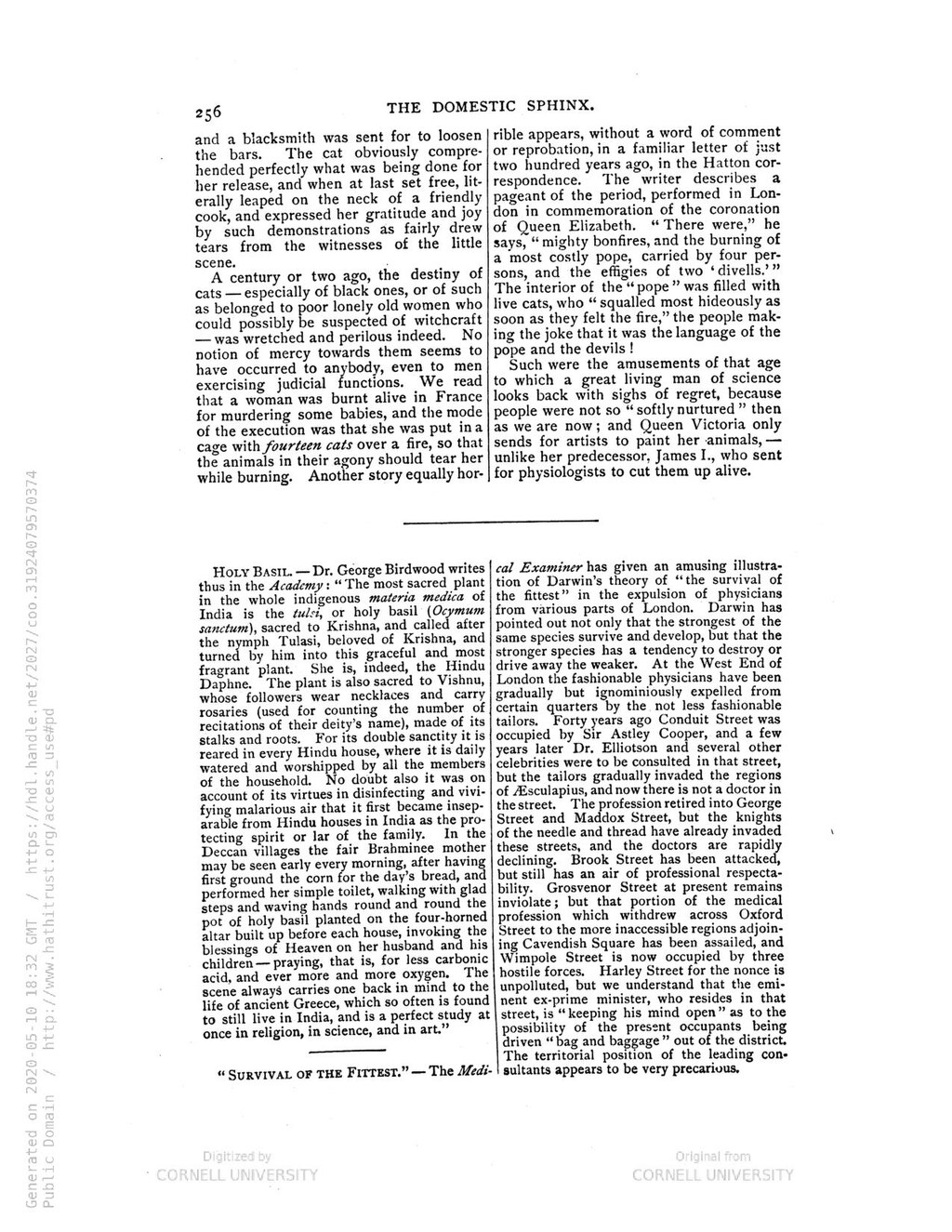and a blacksmith was sent for to loosen the bars. The cat obviously comprehended perfectly what was being done for her release, and when at last set free, literally leaped on the neck of a friendly cook, and expressed her gratitude and joy by such demonstrations as fairly drew tears from the witnesses of the little scene.
A century or two ago, the destiny of cats — especially of black ones, or of such as belonged to poor lonely old women who could possibly be suspected of witchcraft — was wretched and perilous indeed. No notion of mercy towards them seems to have occurred to anybody, even to men exercising judicial functions. We read that a woman was burnt alive in France for murdering some babies, and the mode of the execution was that she was put in a cage with fourteen cats over a fire, so that the animals in their agony should tear her while burning. Another story equally horrible appears, without a word of comment or reprobation, in a familiar letter of just two hundred years ago, in the Hatton correspondence. The writer describes a pageant of the period, performed in London in commemoration of the coronation of Queen Elizabeth. "There were," he says, "mighty bonfires, and the burning of a most costly pope, carried by four persons, and the effigies of two 'divells.'" The interior of the "pope" was filled with live cats, who "squalled most hideously as soon as they felt the fire," the people making the joke that it was the language of the pope and the devils!
Such were the amusements of that age to which a great living man of science looks back with sighs of regret, because people were not so "softly nurtured" then as we are now; and Queen Victoria only sends for artists to paint her animals,—unlike her predecessor, James I., who sent for physiologists to cut them up alive.
Holy Basil.—Dr. George Birdwood writes thus in the Academy: "The most sacred plant in the whole indigenous materia medica of India is the tulsi, or holy basil (Ocymum sanctum), sacred to Krishna, and called after the nymph Tulasi, beloved of Krishna, and turned by him into this graceful and most fragrant plant. She is, indeed, the Hindu Daphne. The plant is also sacred to Vishnu, whose followers wear necklaces and carry rosaries (used for counting the number of recitations of their deity's name), made of its stalks and roots. For its double sanctity it is reared in every Hindu house, where it is daily watered and worshipped by all the members of the household. No doubt also it was on account of its virtues in disinfecting and vivifying malarious air that it first became inseparable from Hindu houses in India as the protecting spirit or lar of the family. In the Deccan villages the fair Brahminee mother may be seen early every morning, after having first ground the corn for the day's bread, and performed her simple toilet, walking with glad steps and waving hands round and round the pot of holy basil planted on the four-horned altar built up before each house, invoking the blessings of Heaven on her husband and his children — praying, that is, for less carbonic acid, and ever more and more oxygen. The scene always carries one back in mind to the life of ancient Greece, which so often is found to still live in India, and is a perfect study at once in religion, in science, and in art."
"Survival of the Fittest."—The Medical Examiner has given an amusing illustration of Darwin's theory of "the survival of the fittest" in the expulsion of physicians from various parts of London. Darwin has pointed out not only that the strongest of the same species survive and develop, but that the stronger species has a tendency to destroy or drive away the weaker. At the West End of London the fashionable physicians have been gradually but ignominiously expelled from certain quarters by the not less fashionable tailors. Forty years ago Conduit Street was occupied by Sir Astley Cooper, and a few years later Dr. Elliotson and several other celebrities were to be consulted in that street, but the tailors gradually invaded the regions of Æsculapius, and now there is not a doctor in the street. The profession retired into George Street and Maddox Street, but the knights of the needle and thread have already invaded these streets, and the doctors are rapidly declining. Brook Street has been attacked, but still has an air of professional respectability. Grosvenor Street at present remains inviolate; but that portion of the medical profession which withdrew across Oxford Street to the more inaccessible regions adjoining Cavendish Square has been assailed, and Wimpole Street is now occupied by three hostile forces. Harley Street for the nonce is unpolluted, but we understand that the eminent ex-prime minister, who resides in that street, is "keeping his mind open" as to the possibility of the present occupants being driven "bag and baggage" out of the district. The territorial position of the leading consultants appears to be very precarious.
